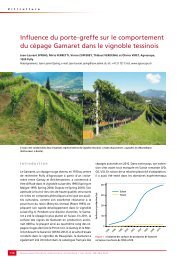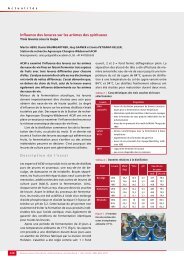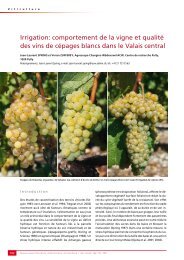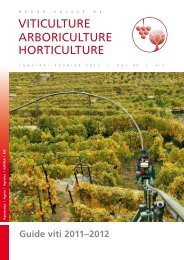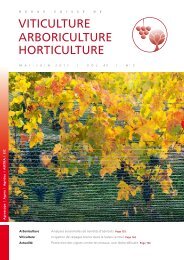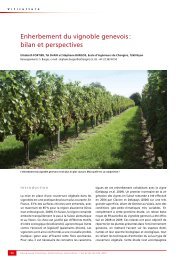Télécharger le PDF - Revue suisse de viticulture arboriculture ...
Télécharger le PDF - Revue suisse de viticulture arboriculture ...
Télécharger le PDF - Revue suisse de viticulture arboriculture ...
You also want an ePaper? Increase the reach of your titles
YUMPU automatically turns print PDFs into web optimized ePapers that Google loves.
Protection <strong>de</strong>s végétaux | Hya<strong>le</strong>sthes obso<strong>le</strong>tus, vecteur du bois noir <strong>de</strong> la vigne : répartition et biologie<br />
Summary<br />
Hya<strong>le</strong>sthes obso<strong>le</strong>tus, the<br />
vector of bois noir: distribution<br />
and biology<br />
Since the appearance of the<br />
quarantine disease flavescence<br />
dorée, Swiss winegrowers’<br />
general awareness for the bois<br />
noir disease has consi<strong>de</strong>rably<br />
increased. Both grapevine<br />
yellows diseases elicit i<strong>de</strong>ntical<br />
symptoms and are transmitted<br />
by insects. Hya<strong>le</strong>sthes obso<strong>le</strong>tus<br />
Signoret (Hemiptera,<br />
Cixiidae) is assumed to be the<br />
principal vector of bois noir in<br />
Europe. Its nymphs normally<br />
<strong>de</strong>velop on the roots of field<br />
bindweed or stinging nett<strong>le</strong>.<br />
Grapevine appears to be only<br />
an erroneous food source for<br />
H. obso<strong>le</strong>tus adults. In Switzerland,<br />
the epi<strong>de</strong>miology of bois<br />
noir disease is at present poorly<br />
un<strong>de</strong>rstood and the interaction<br />
between the phytoplasma,<br />
the insect vector, the original<br />
host plants and grapevines is<br />
unknown. In a first step, we<br />
studied the distribution and<br />
biology of the vector. A<br />
national survey revea<strong>le</strong>d that<br />
H. obso<strong>le</strong>tus is present in most<br />
viticultural areas of Switzerland,<br />
mainly on stinging nett<strong>le</strong>.<br />
Adult planthoppers were captured<br />
from June to September<br />
2008 and they were most abundant<br />
in July. The vector is quite<br />
mobi<strong>le</strong> and capab<strong>le</strong> of flying<br />
over several dozen meters. In<br />
conclusion, H. obso<strong>le</strong>tus and<br />
U. dioica seem to play central<br />
ro<strong>le</strong>s in the epi<strong>de</strong>miology of<br />
bois noir in Swiss vineyards.<br />
Key words: Viticulture, Vitis<br />
vinifera, phytoplasma, stolbur,<br />
plant-vector associations.<br />
Zusammenfassung<br />
Hya<strong>le</strong>sthes obso<strong>le</strong>tus <strong>de</strong>r<br />
Vektor <strong>de</strong>r Schwarzholzkrankheit:<br />
Verteilung und Biologie<br />
Seit <strong>de</strong>m Auftreten <strong>de</strong>r Goldgelben<br />
Vergilbung wird <strong>de</strong>r<br />
Schwarzholzkrankheit <strong>de</strong>utlich<br />
mehr Beachtung geschenkt.<br />
Die bei<strong>de</strong>n Vergilbungskrankheiten<br />
rufen die g<strong>le</strong>ichen<br />
Befallssymptome hervor und<br />
wer<strong>de</strong>n bei<strong>de</strong> von Insekten<br />
übertragen. Hya<strong>le</strong>sthes obso<strong>le</strong>tus<br />
Signoret (Hemiptera,<br />
Cixiidae) scheint <strong>de</strong>r wichtigste<br />
Überträger von Schwarzholz<br />
in <strong>de</strong>r Europa zu sein. Die Nymphen<br />
dieser Glasfügelzika<strong>de</strong><br />
entwickeln sich für gewöhnlich<br />
auf Ackerwin<strong>de</strong>n o<strong>de</strong>r Brennnesseln<br />
und die Rebe zählt<br />
nicht zu <strong>de</strong>n eigentlichen<br />
Futterpflanzen <strong>de</strong>s Überträgers.<br />
In <strong>de</strong>r Schweiz wur<strong>de</strong> die<br />
Epi<strong>de</strong>miologie von Schwarzholz<br />
kaum untersucht und die<br />
Interaktionen zwischen <strong>de</strong>m<br />
Krankheitserreger, seinen<br />
eigentlichen Wirtspflanzen,<br />
seinem Überträger und <strong>de</strong>r<br />
Rebe sind weitgehend unbekannt.<br />
In einem ersten Schritt<br />
haben wir die Verteilung und<br />
Biologie <strong>de</strong>s Überträgers<br />
studiert. Eine lan<strong>de</strong>sweite<br />
Erhebung ergab, dass H. obso<strong>le</strong>tus<br />
in <strong>de</strong>n meisten Schweizer<br />
Weinbau gebieten vorkommt<br />
und dass man das Insekt<br />
hauptsächlich auf Brennnessel<br />
fin<strong>de</strong>t. Auch wenn <strong>de</strong>r Flug im<br />
Sommer 2008 von Juni bis<br />
September dauerte, wur<strong>de</strong>n<br />
am meisten adulte H. obso<strong>le</strong>tus<br />
im Juli gefangen. Die Adulten<br />
sind recht mobil und fliegen<br />
min<strong>de</strong>stens einige zehn Meter.<br />
In <strong>de</strong>n Schweizer Rebbergen<br />
scheinen H. obso<strong>le</strong>tus und<br />
Brennnesseln daher eine<br />
zentra<strong>le</strong> Rol<strong>le</strong> in <strong>de</strong>r Epi<strong>de</strong>miologie<br />
<strong>de</strong>r Schwarz holzkrankheit<br />
zu spie<strong>le</strong>n.<br />
196 <strong>Revue</strong> <strong>suisse</strong> Viticulture, Arboriculture, Horticulture | Vol 42 (3) : 190–196, 2010<br />
Riassunto<br />
Hya<strong>le</strong>sthes obso<strong>le</strong>tus, vettore<br />
<strong>de</strong>l <strong>le</strong>gno nero: ripartizione<br />
e biologia<br />
Coll’apparizione <strong>de</strong>lla flavescenza<br />
dorata, l’attenzione <strong>de</strong>i<br />
viticoltori svizzeri per il <strong>le</strong>gno<br />
nero ha consi<strong>de</strong>revolmente<br />
cresciuto. Questi due giallumi<br />
<strong>de</strong>lla vigna inducono sintomi<br />
i<strong>de</strong>ntici e ambedue sono trasmessi<br />
da insetti. Hya<strong>le</strong>sthes<br />
obso<strong>le</strong>tus Signoret (Hemiptera,<br />
Cixiidae) è consi<strong>de</strong>rato come il<br />
vettore principa<strong>le</strong> <strong>de</strong>l <strong>le</strong>gno<br />
nero in Europa. Le ninfe di<br />
questo insetto si sviluppano<br />
abitualmente sul<strong>le</strong> radici <strong>de</strong>l<br />
vilucchio o <strong>de</strong>ll’ortica dioica e la<br />
vigna non costituisce altro che<br />
una risorsa nutritiva erronea<br />
per gli adulti. In Svizzera, l’epi<strong>de</strong>miologia<br />
di questa malattia è<br />
stata poco studiata e <strong>le</strong> interazioni<br />
tra l’agente patogeno,<br />
<strong>le</strong> sue piante ospiti originarie, il<br />
suo vettore e la vigna non erano<br />
conosciute. In un primo tempo<br />
abbiamo studiato la ripartizione<br />
e la biologia <strong>de</strong>l vettore.<br />
Dei ri<strong>le</strong>vamenti hanno dimostrato<br />
che si trova H. obso<strong>le</strong>tus<br />
nella maggior parte <strong>de</strong>l<strong>le</strong> regioni<br />
vitico<strong>le</strong> <strong>de</strong>lla Svizzera, sopra<br />
tutto sull’ortica dioica. Adulti di<br />
H. obso<strong>le</strong>tus sono stati catturati<br />
da giugno a settembre 2008,<br />
in maggioranza durante il mese<br />
di luglio. Gli adulti sono capaci<br />
di volare almeno su qualche<br />
<strong>de</strong>cina di metri. In conclusione<br />
H. obso<strong>le</strong>tus e l’ortica dioica<br />
sembrano tenere un ruolo <strong>de</strong>cisivo<br />
nell’epi<strong>de</strong>miologia <strong>de</strong>l <strong>le</strong>gno<br />
nero nel vigneto svizzero.



